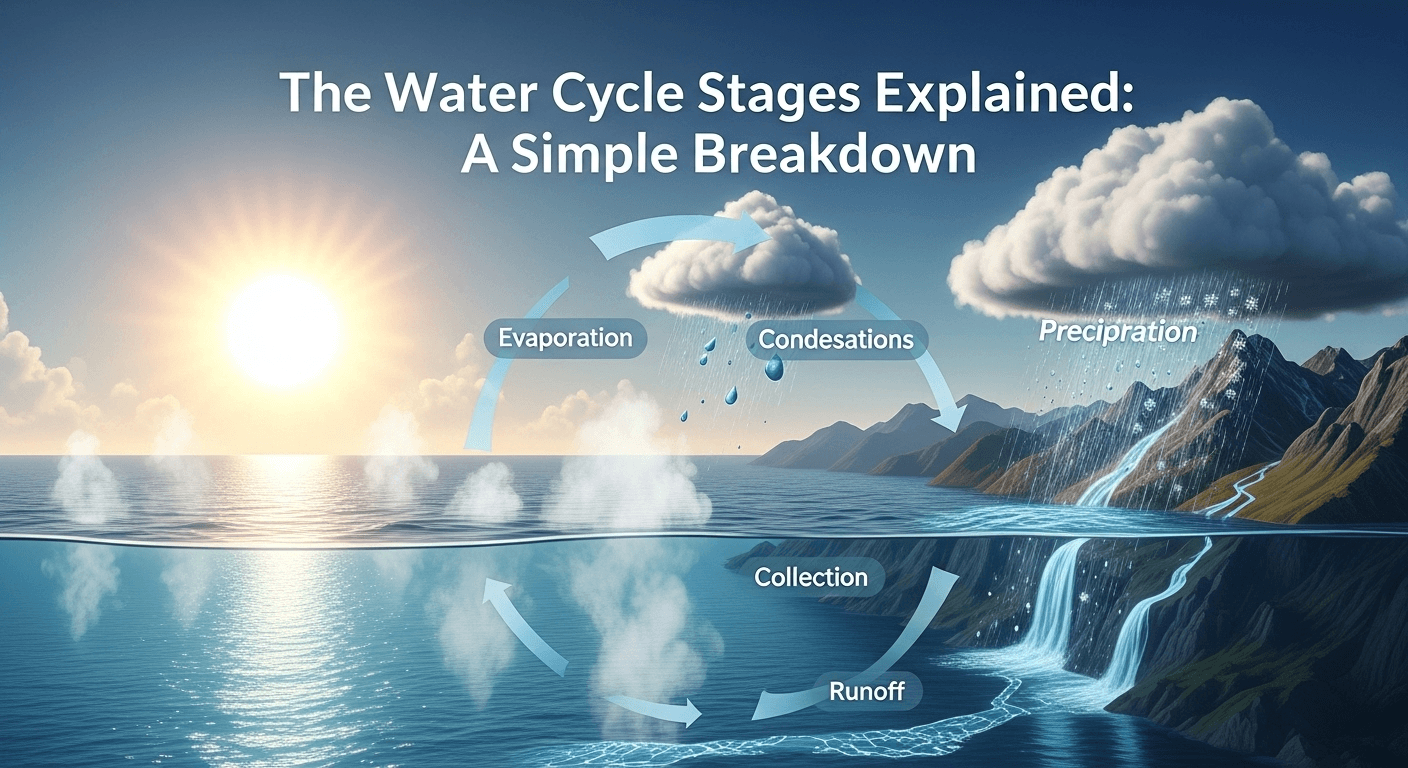Water is the lifeblood of our planet. It covers over 70% of Earth’s surface, makes up about 60% of our bodies, and is essential for every known form of life. But the water you drink today has been on an incredible journey, one that has been repeating for billions of years. This perpetual movement of water on, above, and below the surface of the Earth is known as the water cycle, or the hydrologic cycle. Understanding this process is key to appreciating our planet's most precious resource. In this detailed guide, we will have the stages of the water cycle explained in a simple, easy-to-understand breakdown, exploring each phase of this remarkable natural phenomenon. Water doesn't just sit still; it's in a constant state of flux, changing form from liquid to gas to solid and back again. This continuous process ensures that water is distributed all over the globe, from the deepest oceans to the highest mountain peaks, and into the atmosphere. The main engine driving this entire system is the sun. Solar energy provides the power needed to lift water vapor into the atmosphere, while gravity is the force that brings it back down to Earth. Without these two fundamental forces, the water cycle would cease to exist, and life as we know it would be impossible. The beauty of the water cycle lies in its cyclical nature; there is no true start or end. It's a closed loop where water is constantly recycled. However, to understand it better, scientists typically break it down into four main stages: evaporation, condensation, precipitation, and collection. Along the way, other crucial sub-processes like transpiration, infiltration, and runoff play vital roles. In the following sections, we will journey through each of these stages, observing how water transforms and travels across our planet, sustaining ecosystems and shaping our world's climate and geography. Understanding these stages is more than just a science lesson; it's fundamental to comprehending weather patterns, the availability of fresh water, and the impact of human activities on our environment. From the invisible vapor rising from a lake to the torrential downpour of a thunderstorm, every drop of water is part of this grand, unending voyage. Let's begin our exploration of this fascinating journey. What is the Water Cycle and Why is it Essential? The water cycle, known in scientific terms as the hydrologic cycle, is the continuous circulation of water within the Earth's hydrosphere. This complex system involves the movement of water from the Earth's surface to the atmosphere and back again. It's a colossal purification and distribution network, powered primarily by solar energy. Think of it as Earth’s ultimate recycling program. The total amount of water on our planet has remained relatively constant for billions of years; it’s just constantly changing its form (liquid, gas, solid) and location. The importance of the water cycle cannot be overstated. It is the foundation upon which all life on Earth depends. Firstly, it is the primary mechanism for distributing fresh water across the planet. Oceans hold over 96% of Earth's water, but it's salty and unusable for most terrestrial life and agriculture. The water cycle, through evaporation, effectively desalinates this water, turning it into fresh water vapor that is then transported over land and delivered as precipitation. This process replenishes rivers, lakes, and groundwater, providing the water essential for drinking, sanitation, and farming. Furthermore, the water cycle is a key driver of weather and climate. The movement of water and heat around the globe influences temperature, air pressure, and wind patterns. Evaporation cools surfaces, while condensation releases heat into the atmosphere, impacting atmospheric stability and driving storms. The formation of clouds affects the amount of sunlight reaching the Earth's surface, playing a crucial role in regulating the planet's temperature. In essence, without the constant churning of the water cycle, our planet's climate would be drastically different and far less hospitable. The Upward Journey: Evaporation and Transpiration The first major phase in our journey through the water cycle involves water moving from the Earth's surface up into the atmosphere. This upward movement is primarily achieved through two key processes: evaporation and transpiration. Both involve the transformation of liquid water into water vapor (a gas), but they occur through different pathways. This phase is entirely dependent on energy from the sun. The sun's heat provides the kinetic energy needed for water molecules to break their bonds and escape into the air as an invisible gas. This atmospheric moisture is the raw material for clouds and, eventually, precipitation. While oceans, seas, lakes, and rivers are the largest sources of evaporation, this process happens from any wet surface, including damp soil and even a puddle on the pavement after a rain shower. Combined, evaporation and transpiration are responsible for moving vast quantities of water into the atmosphere every single day, fueling the entire climatic engine. Scientists often use the term evapotranspiration to refer to the sum of water loss from a given area, combining both evaporation from the land surface and transpiration from plants. This combined process is a critical component of water balance calculations for a watershed or ecosystem, helping us understand how much water is available for other uses versus how much is returned to the atmosphere. Evaporation: Water's Great Escape Evaporation is the process where a liquid turns into a gas. In the context of the water cycle, it's how water from oceans, lakes, rivers, and other bodies of water enters the atmosphere as water vapor. The sun's energy heats the surface of the water, increasing the energy of the water molecules. When a molecule gains enough energy, it can break free from the liquid's surface and escape into the surrounding air. This is a constant and silent process, happening all the time, all over the world. Approximately 90% of the moisture in the atmosphere comes directly from evaporation. Several factors influence the rate of evaporation. Temperature is the most obvious one; warmer water evaporates faster. Humidity also plays a big role; evaporation





